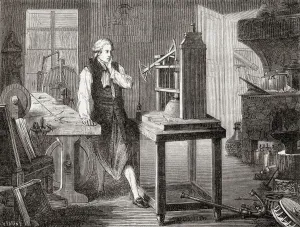Newcomen Collection
In the bustling workshop of James Watt in Glasgow, a remarkable innovation was taking place
All Professionally Made to Order for Quick Shipping
In the bustling workshop of James Watt in Glasgow, a remarkable innovation was taking place. Inspired by Thomas Newcomen's 1712 steam engine design, Watt tirelessly worked to improve upon it. This groundbreaking invention would soon revolutionize industries across the globe. Deep within a coal-mine in the Midlands, a sectional view of Newcomen's steam engine from 1737 reveals its intricate workings. It was this very machine that sparked Watt's curiosity and set him on his path towards greatness. Thomas Newcomen himself, depicted in an image by Smiles, stands as a testament to human ingenuity and perseverance. His creation paved the way for future advancements that would shape our world. Fast forward to 1907 outside Portsmouth newsagents; newsboys eagerly distribute newspapers carrying stories of progress and innovation. Among them is the tale of Newcomen's steam engine - an invention that changed everything. The litho prints showcase both James Watt and Newcomen's engines side by side, highlighting their significance in history. These machines harnessed the power of steam like never before seen, propelling humanity into an era defined by industrialization. A vivid color litho depicts billowing clouds of steam symbolizing progress itself - a visual representation of how these engines transformed societies worldwide. Even decades later in 1956, we witness another iteration: Newcomen's steam engine adapted for draining mines. Its impact continued to be felt long after its initial conception - a testament to its enduring legacy. Attributed to Jean-Rodolphe Perronet in 1767 is yet another variation on Newcomen's design; further proof that this revolutionary technology inspired countless minds throughout history. From humble beginnings emerged an engineering marvel that shaped civilization as we know it today - Thomas Newcomen’s ingenious creation forever etched into our collective memory.
















































